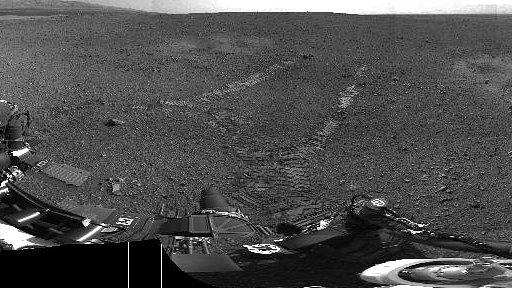Mars rover's big Sam lab up and running
- Published

Curiosity spent six weeks at a dune called Rocknest studying the soil blown about inside Gale Crater
Nasa's Curiosity Mars rover has yet to make a definitive detection of organics - the carbon-rich molecules that can be the "feedstock" for life.
That was one headline result from the first series of soil tests run by its big onboard lab - the Sample Analysis at Mars (Sam) instrument.
But scientists urged patience. Sam's investigations would be slow and methodical, they said.
The target for its first soil test was a dusty dune dubbed Rocknest.
And in truth, it was not the most promising place to start the search for complex carbon compounds, which if present would be severely degraded in the harsh environment that exists at Mars' surface.
"We did not have high expectations that Rocknest would be rich in organics," said Dr Paul Mahaffy, from Nasa's Goddard Space Flight Center and the principal investigator for Sam.
"In fact, it appears to be poor in organics. But the search will continue," he told BBC News.
He was speaking here at the American Geophysical Union (AGU) autumn meeting, the largest annual gathering of Earth and planetary scientists.
It is one of Curiosity's key mission goals to characterise any organic chemistry at its landing site in Gale Crater on Mars equator.
All life as we know it on Earth trades off a source of complex carbon molecules, such as amino acids - just as it needs water and energy.
Previous missions, notably the Viking landers in the 1970s, have hinted at the presence of organics on the planet. But if Curiosity could make the definitive identification in Gale Crater, it would be a eureka moment.
The discovery would not prove the existence of life, but it would go a long way towards demonstrating that the Red Planet did perhaps have habitable environments in its past.
Dr Paul Mahaffy, the principal investigator on Sam, explains how the instrument works
Curiosity, though, has been on Mars just four months. Much of that time has been spent learning how to use the vehicle's suite of tools and instruments.
The complexity of Sam - at 40kg, the biggest instrument on the robot - means its first major analyses of Martian samples have been a while coming.
Three pinches of soil from Rocknest were delivered to Sam by the rover's robotic arm, and the results threw up a sweep of interesting chemistry.
Gases detected from the heating of this fine-grained material included water vapour, carbon dioxide, oxygen and sulphur dioxide.
The water provided a stand-out observation. Because Sam can determine the different forms, or isotopes, of atoms present in a sample, it is able to measure the ratio of "heavy" hydrogen (deuterium) to "normal" hydrogen in the water.
The analysis shows that the Martian water vapour contains five times as much deuterium than that found in typical Earth water. It is heavier, in other words.
This fits with the idea that Mars has lost much of its atmosphere over time. The planet has no global magnetic field to protect air molecules at the top of the atmosphere from being stripped away by the solar wind, and it is the lightest versions of those air molecules that have been preferentially eroded (and the heavier ones preferentially retained).
Some of the chlorine seen by Sam in the first tests is suspected to have come from perchlorates in the soil - possibly calcium perchlorate.
Such compounds first came to the attention of Martian researchers during Nasa's Phoenix lander mission in 2008 which also examined soil samples.
Perchlorates are oxidants and at the time of Phoenix it was suggested they could be reacting with - and destroying - complex organics as the lander's instrumentation heated its samples.
Reactions between perchlorate and carbon-containing molecules would certainly explain some of the simple chlorinated carbon compounds detected by Sam, such as chloromethane and dichloromethane, but Dr Mahaffy is not entirely sure yet the carbon contained in these chemical species comes from the Rocknest soil.
It could just be contamination in the instrument from Earth that has not yet had time to clean itself out.

Soil scooped from Rocknest was delivered to Sam by the rover's robotic arm
"We have to make sure the carbon is not coming from any residual terrestrial carbon that we have in our system. The carbon could also come from inorganic carbon - the carbon dioxide that was released in the tests," he explained.
The only tool on Curiosity still awaiting a debut is its drill. This may be able to retrieve samples from inside rocks that are more favourable for the study of complex organic chemistry than the wind-blown sand at Rocknest.
Prof John Grotzinger said the search was on for a suitable first drill target. Sam would receive a sample from this, as it would from many more locations in Gale Crater in the coming months.
"Curiosity's middle name is patience and we need to have a healthy dose of that," he told reporters.

(A) Curiosity will trundle around its landing site looking for interesting rock features to study. Its top speed is about 4cm/s
(B) This mission has 17 cameras. They will identify particular targets, and a laser will zap those rocks to probe their chemistry
(C) If the signal is significant, Curiosity will swing over instruments on its arm for close-up investigation. These include a microscope
(D) Samples drilled from rock, or scooped from the soil, can be delivered to two hi-tech analysis labs inside the rover body
(E) The results are sent to Earth through antennas on the rover deck. Return commands tell the rover where it should drive next
Jonathan.Amos-INTERNET@bbc.co.uk and follow me on Twitter: @BBCAmos, external
- Published16 November 2012

- Published10 November 2012
- Published31 October 2012

- Published19 October 2012

- Published17 October 2012
- Published27 September 2012

- Published22 August 2012
